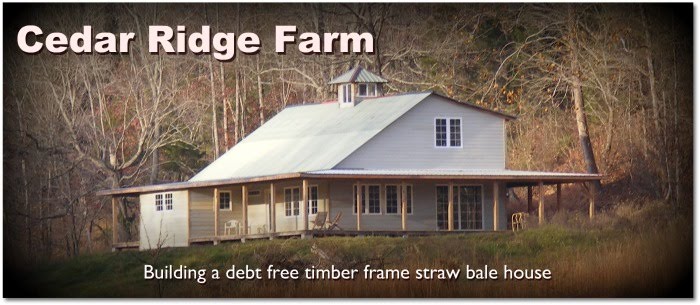The second coat (also called the brown or infill coat) of plaster takes a lot of mud. Of course, we already knew that based upon our plastering experiences two years ago when we finished the exterior of the house.
The recipe that I’ve been using for the second coat is different than the recipe for the first coat (also called scratch or discovery coat). The first coat has a fairly high clay content. I used 1.5 parts clay-rich dirt to 2 parts sand. It can be done with equal parts clay and sand (there are variations depending on the clay content of the dirt being used). The more clay there is in the mix, the more cracking that occurs when the plaster dries. This is because clay expands when wet and shrinks when it dries. So, as the plaster dries, it naturally shrinks, and the shrinkage causes cracks (something has to give somewhere). For the first coat, that’s not a big deal – the cracks will be filled by the next coat and will actually help the second key into the first.
For the second coat I started with a mix using 1 part clay to 2 parts sand, but I’ve adjusted that on the last four batches to 1 part clay to 2.5 parts sand. Although cracks on this coat of plaster aren’t a real problem because they will be covered by the finish coat, I would like to minimize them as much as is realistic.
I’ve noticed that cracks are more apt to appear in areas where the plaster is thicker on the wall, presumably because the thinner areas surrounding the thicker dry faster, shrinking as they do. The thicker areas take longer to dry and are still wet enough to be weaker and therefore the first place to give. Less clay in the mix will allow less shrinkage and fewer cracks. The important part is that the plaster be strong enough, a characteristic dependent to a large extent upon the clay which is the substance that binds the plaster together, that makes it work (sand and water doesn’t make a good plaster).
We’ve mixed 12 batches of plaster for the second coat so far. We started in the kitchen, because I want the walls there to dry so we can put up the green board. They are mostly dry now, with only a few areas still damp. The weather played a role in that – it was humid and overcast with rain for several days. That’s not good drying weather. But, drier weather has returned, allowing the process to continue as needed.
The kitchen windows were the first ones I did with the second coat. They went well. The greatest challenge is above the windows. Somehow, gravity seems to work against me, causing plaster to fall. Sometimes it’s because it sticks to my hands more strongly than it sticks to the first coat, I think. But, once it’s pressed in firmly and troweled, it does fine. 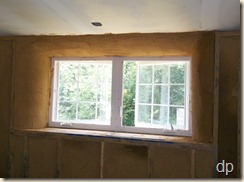 It’s just initially that a fair bit falls to the window sill. I pick it up and use it anyway (it’s not like it’s going to get dirty).
It’s just initially that a fair bit falls to the window sill. I pick it up and use it anyway (it’s not like it’s going to get dirty).
After the plaster is troweled and shaped, the windows look good. The important thing is to get the shape on the walls with this coat. Around the windows that means the curves I want. On the rest of the walls, the kitchen walls excepted, the idea is to even them out and give them the shape and smoothness desired in the final product.  There will be a few areas that will need a third coat, though – some of the low spots require 4 inches or so of plaster, and that is too much at one time in some areas.
There will be a few areas that will need a third coat, though – some of the low spots require 4 inches or so of plaster, and that is too much at one time in some areas.
After the kitchen, we moved along the wall into the dining room. This wall has the most area to be plastered of all the wall sections. It’s 14 feet long, 9 feet tall, and has only one window. We finished it yesterday and then moved on to the living room walls. As you can imagine looking at the photo (to the right – click to e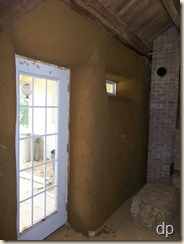 nlarge any of the photos), the areas above the braces on the timber frame present some challenges because of the limited space to work in.
nlarge any of the photos), the areas above the braces on the timber frame present some challenges because of the limited space to work in.
The wall near the chimney behind where the wood stove will be located presented the challenge of plastering behind the chimney. It wasn’t too bad, and, thankfully, it will not be seen anyway. 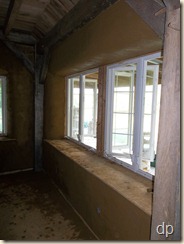 This section of wall will require a third coat in places because of the depth of some low spots.
This section of wall will require a third coat in places because of the depth of some low spots.
We moved on from the chimney, around the front door and to the double windows in the living room. We didn’t finish the living room walls today, but we’ve got a good start. It should only take one more batch to finish the second wall. The front wall is done.
We mixed and applied three batches of finish coat on the interior packed walls in the master bedroom earlier in the week. Interestingly, the finish plaster that we put on the upstairs walls a 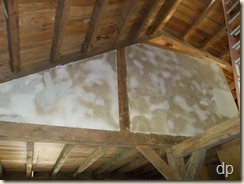 few weeks ago did not dry white as expected. It is white in places, but not as uniformly as I anticipated, like it did when I did a test patch last year after buying the kaolin clay. The only difference I know of in the mix is the addition of wheat paste. I bought some dried wheat past to help bind the plaster together, and I think it is keeping some of the clay from working to the surface when I hard trowel and buff the plaster. That’s okay because we’re going to paint all the walls with a clay paint anyway. The wheat paste does a good job binding
few weeks ago did not dry white as expected. It is white in places, but not as uniformly as I anticipated, like it did when I did a test patch last year after buying the kaolin clay. The only difference I know of in the mix is the addition of wheat paste. I bought some dried wheat past to help bind the plaster together, and I think it is keeping some of the clay from working to the surface when I hard trowel and buff the plaster. That’s okay because we’re going to paint all the walls with a clay paint anyway. The wheat paste does a good job binding 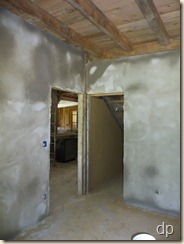 the plaster, though, and it keeps the clay from dusting off if you rub on it. It makes a nice finished surface.
the plaster, though, and it keeps the clay from dusting off if you rub on it. It makes a nice finished surface.
It looks like the walls in the bedroom may dry mottled in color, too. There are a few cracks that have developed as the plaster is drying. I’m going to adjust the amount of clay in the recipe. My books recommended more clay in the final coat than I expected, and I went with their recommendation. I think less clay will still work fine and will allow fewer cracks. I need to get some silica sand so that I can mix up some plaster with it to repair the cracks. Masonry sand, even when screened through a window screen, has too many large pieces to make a good patch plaster. I’m going to want some fine silica sand for the clay paint anyway.
In the next few weeks, I’m going to experiment with the clay paint, mixing up different batches to find a recipe that I like. It should be fun trying it out with additives like mica powder and/or mica flakes. I also have some natural yellow ochre pigment to see if I can come up with a nice pale yellow.
